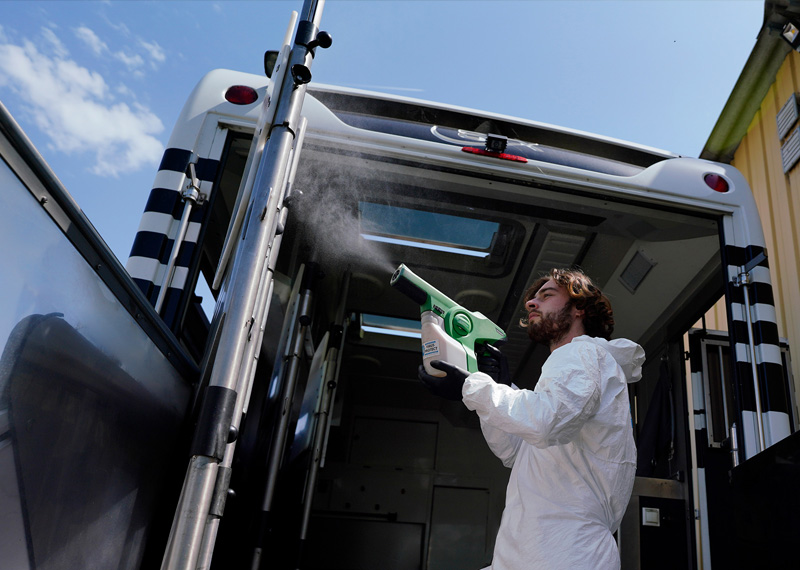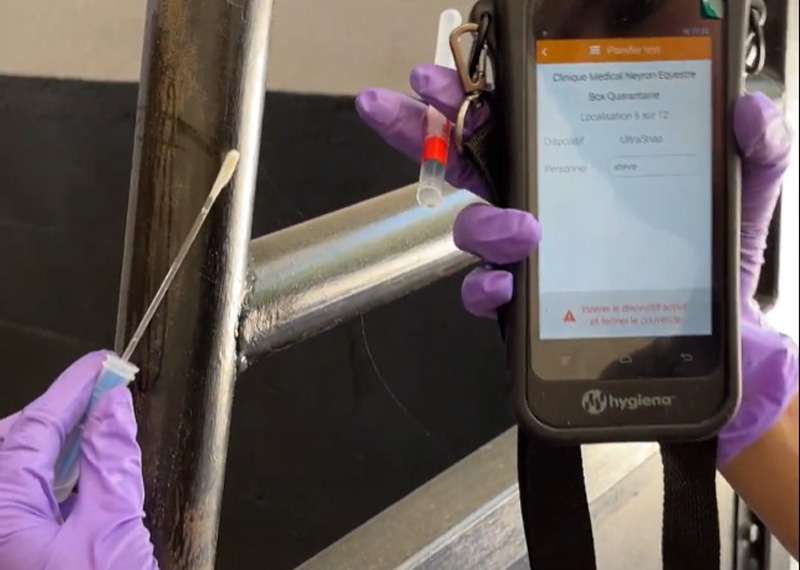why disinfect ?
International transports are subject to strict regulations regarding animal health and biosecurity, including disinfection standards. Complying with these regulations while ensuring effective disinfection can be complex, especially when navigating between different jurisdictions.
An additional major challenge in the disinfection of equestrian transport lies in the difficulty of ensuring and verifying that surfaces have been properly disinfected and whether the staff had enough time to perform these operations between each animal transport. This uncertainty can increase the risk of disease spread for several reasons:
v
Lack of Visibility: Unlike other equine care procedures, the disinfection of transport vehicles is not always visible or easily verifiable by breeders or horse owners. This can lead to doubts about the quality and effectiveness of the disinfection measures applied.
Time Constraints: Tight schedules and delivery deadlines may limit the available time for thorough disinfection between animal loadings. This is particularly true in air and road transport contexts where time is often a critical factor.
Staff Training and Awareness: Variability in the training and awareness of staff responsible for disinfection can affect the consistency and effectiveness of disinfection. Without a clear understanding of protocols and the importance of disinfection, staff may not give this task the attention it deserves.
Documentation and Tracking: The absence of detailed documentation or tracking systems to verify that disinfection has been performed according to established standards complicates the task of ensuring a safe and pathogen-free environment for each transport.
Stress and Immune System: Transport, especially over long distances, can be a significant source of stress for horses, which can weaken their immune system and make them more susceptible to infections. Effective disinfection is therefore essential to minimize disease risks in a context where animals are already vulnerable.
Cross-contamination: Transport vehicles and airplanes can successively carry different groups of animals, increasing the risk of cross-contamination among horses. Disinfection between each transport is crucial to prevent disease transmission.
Logistical Challenges: Effective disinfection of transport means requires specific protocols adapted to each type of vehicle (trucks, trailers, airplanes) and their various surfaces. This can represent a significant logistical challenge, particularly in terms of the time needed for complete and effective disinfection.
Pathogen Control: Some pathogens can survive on surfaces for long periods. The choice of disinfectants and the method of application must be adapted to ensure the effective eradication of these resistant pathogens.
International Regulations: International transports are subject to strict regulations regarding animal health and biosecurity, including disinfection standards. Complying with these regulations while ensuring effective disinfection can be complex, especially when navigating between different jurisdictions.
Animal Safety and Welfare: The disinfection products used must be effective against pathogens while being safe for horses. The use of harsh chemical products can pose health risks to the animals and people involved in transport.
Air Sanitization
If the primary use of PhotoACTIVE Equine is long-term surface disinfection, its mechanism of action also involves the destruction of VOCs (Volatile Organic Compounds), which are air pollutants. Applying it to large surfaces in confined spaces such as stables and vehicles can drastically reduce odors and the associated chemical aggressions for the respiratory tract, such as ammonia vapors:
- Respiratory Irritation: Ammonia can irritate the respiratory tract of horses, leading to inflammation and increasing the risk of chronic respiratory diseases.
- Decreased Performance: Respiratory problems can affect exercise capacity and overall performance of the horse.
- Effects on Young Horses: Foals and young horses are particularly sensitive to ammonia due to their developing respiratory system.
These effects can, over time, impact the quality of life and potentially reduce the longevity of horses. By reducing the presence of ammonia and other VOCs, PhotoACTIVE Equine not only contributes to a cleaner and more hygienic environment but also helps in maintaining the respiratory health of horses. This is particularly important in equestrian settings where air quality directly affects the health and performance of the animals.
How PhotoACTIVE Equine can help you
PhotoACTIVE Equine can significantly assist professionals involved in horse transport by addressing several key challenges related to biosecurity and disease prevention. Here’s how this innovative solution can be beneficial:
Enhanced Disinfection Efficiency: PhotoACTIVE Equine’s powerful antimicrobial properties ensure a thorough disinfection of transport vehicles and equipment, effectively eliminating bacteria, viruses, and fungi that can cause diseases in horses. Its ability to provide comprehensive surface coverage helps in reducing the risk of cross-contamination among horses during transport.
Long-lasting Protection: Unlike conventional disinfectants that offer immediate but short-lived protection, PhotoACTIVE Equine creates a durable antimicrobial layer on surfaces. This long-lasting effect ensures that vehicles and equipment remain sanitized over extended periods, offering continuous protection against pathogens between transports.
Reduced Stress on Animals: By minimizing the risk of infection, PhotoACTIVE Equine contributes to a healthier transport environment, thereby reducing the stress associated with illness in horses during transit. A lower stress level can help in maintaining the animals’ immune systems, making them less susceptible to infections.
Time and Cost Efficiency: The residual effectiveness of PhotoACTIVE Equine reduces the need for frequent reapplications of disinfectant, saving time and resources for transport professionals. This efficiency can be particularly valuable during busy transport schedules, ensuring that disinfection protocols do not delay operations.
Compliance with International Regulations: PhotoACTIVE Equine’s proven effectiveness and safety profile can help transport companies comply with stringent international biosecurity regulations. By using a product that meets global health and safety standards, transporters can navigate regulatory requirements more easily, facilitating international movements.
Safety for Horses and Humans: Formulated to be safe around animals and humans, PhotoACTIVE Equine ensures that the disinfection process does not expose horses or transport staff to harmful chemicals. This safety feature is critical for maintaining a healthy environment for everyone involved in the transport process.
Environmental Considerations: With an emphasis on environmental sustainability, PhotoACTIVE Equine offers a more eco-friendly approach to disinfection. By reducing the need for frequent applications and using safer chemical formulations, it minimizes the ecological impact of transport disinfection practices.
In summary, PhotoACTIVE Equine provides a comprehensive solution to the disinfection challenges faced by horse transport professionals, enhancing biosecurity measures, ensuring animal welfare, and streamlining operational efficiencies. Its use can significantly contribute to the overall success and reliability of horse transportation services.




